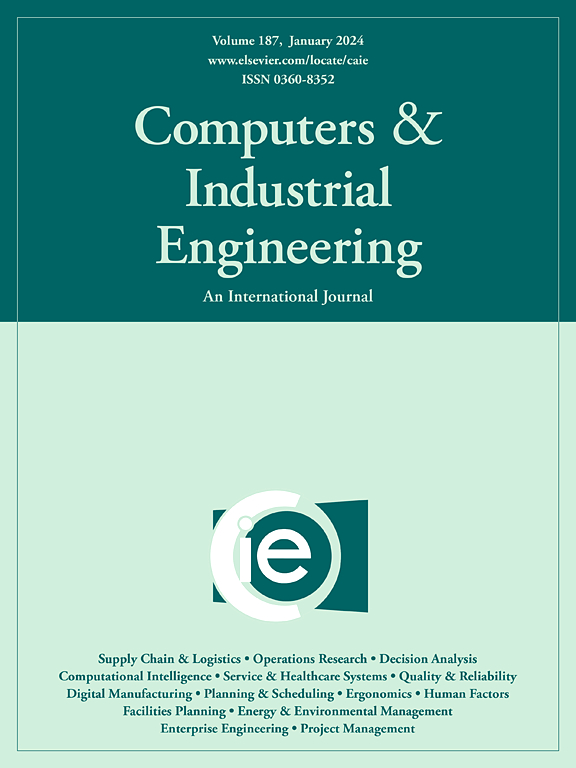An integrated simulation–optimization method for flexible assembly job shop scheduling with lot streaming and finite transport resources
IF 6.7
1区 工程技术
Q1 COMPUTER SCIENCE, INTERDISCIPLINARY APPLICATIONS
引用次数: 0
Abstract
Lot streaming (LS) in manufacturing enhances production efficiency but often leads to increased job waiting times and prolonged makespan when combined with assembly job shop scheduling. The practical constraint of finite transport resources (TRs) is prevalent in practice but is frequently overlooked or simplified. This study addresses the Flexible Assembly Job Shop Scheduling Problem incorporating LS and finite TRs (FAJSSP-LS-TRs), where jobs are divided into equal-sized sublots, each requiring specific TRs with limited capacity for movement between machines and assembly stations. To efficiently explore the complex interplay between time-sensitive machining, transportation, and assembly activities within a network of heterogeneous TRs, we introduce an integrated simulation–optimization approach to minimize the makespan, using a self-repair genetic algorithm to optimize LS strategy, job operation allocation, machine processing sequence, and TRs designation. A case study in a furniture manufacturing workshop yields several pivotal insights: Firstly, practical constraints like setup time and finite TRs significantly affect the benefits of job splitting for makespan reduction. Secondly, compared to a single lot sizing strategy, a mixed lot sizing (LS-Mix) strategy leads to makespan reductions across varying-sized problem instances. Thirdly, the LS-Mix strategy outperforms the approach of merely increasing the number of TRs. Finally, managerial insights are derived.
具有批量流和有限运输资源的灵活装配作业车间调度的综合模拟优化方法
制造业中的批量流水作业(Lot streaming,LS)可以提高生产效率,但在与装配作业车间调度相结合时,往往会导致作业等待时间增加和生产周期延长。有限运输资源(TRs)这一实际约束在实践中非常普遍,但经常被忽视或简化。本研究探讨了包含 LS 和有限 TRs 的灵活装配作业车间调度问题(FAJSSP-LS-TRs),在该问题中,作业被划分为大小相等的子批次,每个子批次都需要特定的 TRs,而这些 TRs 在机器和装配工位之间的移动能力是有限的。为了有效探索异构 TRs 网络中对时间敏感的加工、运输和装配活动之间复杂的相互作用,我们引入了一种综合仿真优化方法,利用自修复遗传算法来优化 LS 策略、作业操作分配、机器加工顺序和 TRs 指定,从而最大限度地缩短生产周期。通过对家具制造车间的案例研究,我们获得了一些重要启示:首先,设置时间和有限的 TRs 等实际限制因素会极大地影响作业拆分对缩短生产周期的益处。其次,与单一批量大小策略相比,混合批量大小(LS-Mix)策略能在不同大小的问题实例中减少作业间隔。第三,LS-Mix 策略优于单纯增加 TR 数量的方法。最后,得出了管理启示。
本文章由计算机程序翻译,如有差异,请以英文原文为准。
求助全文
约1分钟内获得全文
求助全文
来源期刊

Computers & Industrial Engineering
工程技术-工程:工业
CiteScore
12.70
自引率
12.70%
发文量
794
审稿时长
10.6 months
期刊介绍:
Computers & Industrial Engineering (CAIE) is dedicated to researchers, educators, and practitioners in industrial engineering and related fields. Pioneering the integration of computers in research, education, and practice, industrial engineering has evolved to make computers and electronic communication integral to its domain. CAIE publishes original contributions focusing on the development of novel computerized methodologies to address industrial engineering problems. It also highlights the applications of these methodologies to issues within the broader industrial engineering and associated communities. The journal actively encourages submissions that push the boundaries of fundamental theories and concepts in industrial engineering techniques.
 求助内容:
求助内容: 应助结果提醒方式:
应助结果提醒方式:


